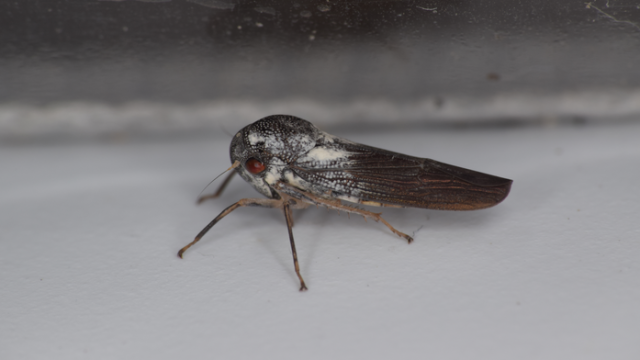Researchers in western Uganda found a new species of leafhopper insect, the first sighting of any animal from its genus seen since 1969. The red-eyed, metallic-looking animal resembles the legendary Mothman and is nearly as rare.
Leafhoppers are common insects that are considered destructive pests due to their love of crops. But Phlogis, the genus that the recently discovered critter belongs to, is extraordinarily rare, with the last confirmed sighting taking place in the Central African Republic half a century ago. The new species’ discovery was reported this month in Zootaxa.
“Leafhoppers of this genus, and the wider tribe, are very unusual in appearance, and are rarely found,” said Alvin Helden, an entomologist at Anglia Ruskin University in the UK and the lead author of the new paper, in a university release. “In fact, they are so incredibly rare that their biology remains almost completely unknown, and we know almost nothing about Phlogis kibalensis, the new species.”
P. kibalensis is named for Kibale National Park, where the insect was found by a team of student entomologists led by Helden. The animal is just a quarter-inch long and has six spindly legs and a reflective silver body with reddish-brown wings. Its eyes are bright red, and, like other male leafhoppers, it has leaf-shaped genitalia.
Helden added that we still don’t know what P. kibalensis eats or its ecological niche. Leafhoppers are closely related to cicadas, though, and it’s likely that the new species feeds on plant sap as other leafhoppers do. They are eaten by birds and other invertebrates like spiders, beetles, and wasps, which Helden has been surveying in the Ugandan wildlife park since 2015.
“Outside national parks and reserves, the amount of rainforest that has been cleared in the tropics is devastating,” he said. “Rare species could be living anywhere, but deforestation means it is inevitable that we will be losing species before we have discovered them.”
Indeed, African wildlife parks harbour fauna big and small that are little known to scientists. Last year, a Walker’s duiker — a species of antelope never before imaged alive in the wild — was caught on trail cameras in Togo.
Of course, an insect as small as P. kibalensis can’t easily be spotted by trail cameras, making boots-on-the-ground documentation a vital means of research. Environmental DNA has become a more reliable method of finding elusive species in recent years, so more insects may yet enter our vocabulary.
More: 7 ‘Extinct’ Species That Eventually Reappeared
Editor’s Note: Release dates within this article are based in the U.S., but will be updated with local Australian dates as soon as we know more.
